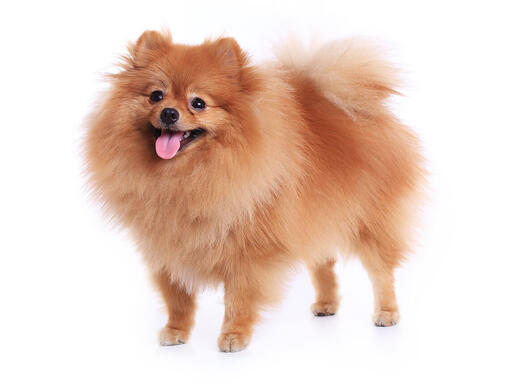
A cocky, animated dog of Nordic descent, the Pomeranian originally weighed nearly 13 kilograms and served as a sheep herder. The breed was reduced in size in the historical region of Pomerania, which today is Germany and Poland. An extrovert with great intelligence and a vivacious spirit, the Pomeranian can be an excellent family dog. The breed’s protective demeanor makes him a good watchdog as well. The Pomeranian does not require much exercise, but his thick coat needs regular brushing.
DID YOU KNOW? The popularity of the Pomeranian dramatically increased when Queen Victoria brought one back to England from Italy in 1888. A Pomeranian named “Turi” lay next to the Queen at her death.
ALSO KNOWN AS: Deutscher Spitz, Zwergspitz, Spitz nain, Spitz enano, Pom, Zwers
The need-to-know
- Dog suitable for non-experienced owners
- Basic training required
- Enjoys gentle walks
- Enjoys walking half an hour a day
- Little toy dog
- Some drool
- Requires grooming daily
- Non hypoallergenic breed
- Very vocal dog
- Guard dog. Barks and alerts
- Great with other pets
- Great family dog
Personality

They are lively and energetic little dogs who are very loyal to their families, although generally bond to one person. Pomeranians enjoy being handled and spending time with their beloved owner but it’s important that they have the opportunity to be ‘real dogs’. They make excellent watch dogs, as they are quite vocal and will alert to anything unusual - or indeed to just about anything! Despite their gentle and affectionate natures and surprisingly enthusiastic attitude to life, care must be taken, as under all that hair they are tiny and quite fragile.
History and Origins

Country of Origin: Germany
Unlikely as it may seem, Pomeranians (or 'Poms') are almost certainly descended from the sledge-pulling dogs of the Arctic and are probably related to the Keeshond, Norwegian Elkhound and the Samoyed. This small pet dog was intentionally bred through progressive size reduction although when they arrived in the UK with German-born Queen Charlotte they were very different from the Poms we know today - being white and much larger (9-14kgs). They soon became popular, especially with royalty, so when Queen Victoria visited Florence and saw much smaller various of the breed there, she brought them home with her. The Queen went on to breed them and showed them at Crufts in 1891 where (not surprisingly!) she won best of breed. In the years that followed her death in 1901, selective breeding for a smaller size continued until the tiny dog we know today was developed and the larger sizes vanished entirely from the UK.
Nutrition and Feeding

Toy dogs have a fast metabolism, meaning they burn energy at a high rate, although their small stomachs mean that they must eat little and often. Small-breed foods are specifically designed with appropriate levels of key nutrients and smaller kibble sizes to suit smaller mouths. This also encourages chewing and improves digestion.
Exercise

Pomeranians are very undemanding in their exercise requirements and are quite happy with short daily walks or a run in the garden with their owners. If kept fit and active however they can enjoy much longer walks. Their primary focus is social contact with their owner but as a descendant of working breeds, they do enjoy interactive enrichment games to keep their busy mind occupied and to stop them getting bored and overly noisy.
Other Information

Health and common issues
Like many small breeds, the Pomeranian can suffer from kneecaps that may temporarily slip out of place (luxating patellas). Other common problems in Poms are eye conditions, a disorder causing hair loss and a windpipe problem that causes coughing.
Space requirements
Pomeranians can live in just about any home as they do not need much space. They do need access to outdoor spaces for daily walks and toileting (especially as to successfully toilet train them, you do need to be able to get them out very frequently).
Training pomeranians
It’s easy to underestimate these tiny dogs but they are surprisingly trainable and enjoy working with their owner. Poms have been known to compete successfully in mini agility as well as learn all kinds of tricks. At the least they should be taught to walk on a harness and have a good recall (not that they generally go far from their owner). Like many toy breeds, expect toilet training to take far longer than in larger breeds.
Best family dog breeds
Although the Pom is friendly and gets on with everyone, they are too delicate for active or boisterous young families. They will do well in a family of older sensible children however. While many dogs are traditionally thought of as being good with children, all dogs and children need to be taught to get on with and respect each other, and be safe together. Even so, dogs and young children should never be left alone together and adults should supervise all interactions between them.
Did you know?
- When Poms first came to the UK, they were very much the canine supermodels of the time. Artist Gainsborough was particularly taken with the breed and painted them several times. This was possibly what led to their popularity - especially among the aristocracy.
- Their connection to the arts doesn’t stop there either, Mozart had a Pomeranian named Pimperl, to which he dedicated an aria to and Michelangelo had a Pom by his side whilst he painted the ceiling of the Sistine Chapel.
- Two Pomeranian’s survived the sinking of the Titanic in 1912.
- One of the most internet famous dogs ever, was a Pomeranian called Boo. He had 16 million Facebook fans when he passed away in January 2019.
- Pomeranian’s have one of the smallest litter sizes with the average being around 2 – 3 puppies per litter.